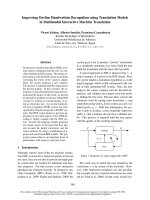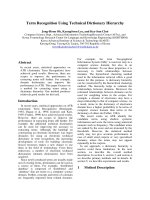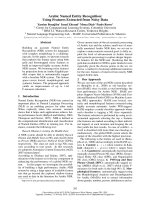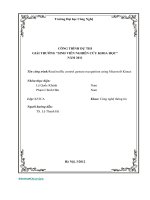Elevator Motion States Recognition Using Barometer
Bạn đang xem bản rút gọn của tài liệu. Xem và tải ngay bản đầy đủ của tài liệu tại đây (700.52 KB, 7 trang )
Elevator Motion States Recognition Using Barometer
Support Indoor Positioning System
Nguyen Van Duong1, Pham Van Thanh1,2, Tran Van An2, Nguyen Tuan Khai1, Duong
ThiThuy Hang1, Hoang The Hop1, Tran Duc Tan1
1VNU
2The
Hanoi University of Engineering and Technology Hanoi, Vietnam
University of Fire Fighting and Prevention (UFFP), Hanoi, Vietnam
Abstract. Indoor positioning is widespread applications in health monitoring,
navigation and other indoor position services. There are a variety of researches
focusing on solving indoor position problems, but most of them are using the
accelerometer to solve horizontal positions. Nevertheless, there are a lot of
buildings and houses where people are using the elevator to move among the
floors. Hence, it is difficult to estimate the positions vertically when the users
use the elevator in motion. This paper aims to integrate a barometer in indoor
positioning system (IPS) for elevator motion recognition and proposes a new
feature name “pressure standard deviation” from barometer recording data to
distinguish among elevator up, elevator down, still, stairs up, stairs down to
track the position of user in vertical axis. Our experimental results achieve
100% accuracy in distinguishing the state of elevator up, elevator down, still,
stairs up, stairs down and estimate exactly and real-time in vertical axis.
Keywords: Indoor Positioning System, Barometer, Elevator, Vertical Position,
Pressure Standard Deviation.
1
Introduction
Activity recognition is important for widespread applications like IPS, patient
tracking, health monitoring. Recently, most of the researches have focused on using
acceleration data for activities classification. Nevertheless, the limitations of
acceleration data are difficult to estimate the activities in vertical. Using built-in
smartphone sensor like accelerometer, barometer, Global Positioning System (GPS),
Wi-Fi, Bluetooth,… is more and more popular because these sensors are integrated in
a smartphone. The GPS is unreliable for IPS because it is unstable in indoor
environments. Using Wi-Fi and Bluetooth requires pre-installed system to emit and
transfer the signal among the insides and between the inside and the outside. Hence, it
is not applicable for indoor positioning applications like firefighting and rescue
because the pre-installed system may be destroyed by flame and heat from burning
fire.
In the Refs [1], [6] and [7], the authors proposed to use the accelerometer for state
classification. The accelerometer is only suitable to estimate the states of walking,
2
running and still state horizontally. The accelerometer reading in the vertical is not
very different among in-elevator up, in-elevator down and still states. Furthermore,
using accelerometer in stairs up, stairs down and walking classification achieves low
accuracy because the accelerometer reading values are not very different in these
states.
The publication [8], [9] used barometer in vertical estimation, the authors
proposed to integrate this sensor for measuring the pressure without eliminating
abnormal parts in barometer reading. Hence, the reading values of the barometer will
be affected by environment like weather, temperature and humidity and noise in
sensor or the suddend change of air pressure.
Based on the above limitations, this paper proposes to integrate barometer in our
IPS and to add new feature “pressure standard deviation” to eliminate abnormal part
in barometer reading.
2
System Design
2.1. The 3-DOF accelerometer
The 3-DOF accelerometer is used to acquire the acceleration in three axis Ax, Ay
and Az. This kind of sensor is also popular in outdoor positioning system [9-14].
Nevertheless, the accelerometer is only applicable to distinguish among activities like
running, walking and still states by using the magnitude of acceleration as:
An = √A2x + A2y + A2z ,
(1)
The acceleration data is difficult to recognize amongst still states, in-elevator up,
in-elevator down and walking stairs up, walking stairs down and walking on the floor.
It can be seen that, the Fig.1 shows the acceleration (m/s2) of walking stairs up,
walking stairs down and walking on the floor (see Fig.1). Also, it is difficult to
distinguish among these states when using only the accelerometer for states
classification.
Fig.1. Acceleration magnitude of walking stairs up, walking stairs down and
walking on the floor
3
2.2. Barometer BMP180 and Map Information
a) Barometer BMP180
BMP180 is a sensor used to measure pressure and temperature. The temperature
parameter supports to calculate the pressure of the environment because the pressure
depends directly on the temperature, weather and humidity of the environment. Based
on current measured pressure 𝑝 and the pressure at sea level𝑝0 = 1013.25 hPa to
calculate the altitude by using the international barometric formula [5]:
1
𝑎𝑙𝑡𝑖𝑡𝑢𝑑𝑒 = 44330 ∗ (1 −
𝑝 5.255
( )
),
𝑝0
(2)
Based on the 𝑎𝑙𝑡𝑖𝑡𝑢𝑑𝑒 value and map information (see Fig. 2b and Fig.3) we can
estimate the vertical position of the user. Nevertheless, the barometer reading has always
existed an abnormal signal (see Fig.2a), it leads to the wrong position estimation (see Fig.
2) when we integrate barometer into an IPS without eliminating abnormal parts in the
signal.The raw measured pressure data may cause the wrong prediction vertical
position as the Fig.2:
a)
b)
Fig.2. a) The raw measured pressure 𝑝 (mb) and b) the altitude based on the raw
measured pressure
b) Map Information
All buildings need designing before constructing, and there are all parameters like
the height of the building, the height of each floor, stairs and elevators positions…etc
that are also clarified (see Fig. 3). These are useful information to support for finding
the position of users inside of the building.
2.3. The Proposed Method
a) System Design
The proposed IPS integrates of a micro controller unit (MCU) STM32F103C8T6, a
low-cost 9-DOF IMU MPU-9250 (9-axis Motion Processing Unit), a wireless data
transmitter/receiver, a barometer BMP180 and other supporting sensors for data fusion.
The Fig.4 is the flowchart of our proposed method. Firstly,BMP180 sensor will
record pressure data. In order to find out exactly the pressure data, the sensor is
integrated temperature sensor. Based on recorded data, we have proposed new feature
4
“pressure standard deviation” to solve abnormal parts in recorded data. Then, basing on
the changing of pressure to estimate in-elevator states and floor level.
b) The Pressure Standard Deviation
To detect the level of the floor, we uses the heightwhichis calculated from the
processed pressure data by the formula (2). The data in each window are a group of 4
barometer samples (baro(i), baro(i+1), baro(i+2), baro(i+3)). The pressure standard
deviation algorithm is usedfor calibration data as Fig.5.
Fig.4. The flowchart of our
proposed method
Fig.3. The map information of a building
(the building height, floor height, elevators
and stairs positions)
5
Fig.5. The flow chart of our proposed “Pressure Standard Deviation” feature
To eliminate abnormal signal recorded from a barometer, we proposes that: if
abs(baro(i) - D)≤Th1 then baro(i) = baro(i)else baro(i) = baro(i-1). Then the altitude
can be derived from the measured pressure as in (1). We can distinguish being still
from being in a vertical motion state by calculating the difference of data after 2s. If
the difference is larger than the threshold, it can be considered that the user is moving
vertically. With the given building schematics, we are able to estimate the instant
altitude of the user and which floor the user is currently in.
3
Results and Discussions
For the experiment testing, we carried out a test on 6 firefighters selected from
The University of Fire Fighting and Prevention (UFFP) age range of 18- 22, height:
1.65m – 1.78m, weight: 65 kg – 79 kg. The volunteers recorded two types of data:
walking – elevator up – walking - elevator down – walking and stairs up – stairs
down. For each type of data, the volunteer would record 3 times.
The Fig.6 and Fig.7 bellow illustrates the altitude and position of firefighters in
vertical position
6
a)
b)
Fig.6.a) The measured pressure (mb) and b) The altitude (m) after using the “pressure
standard deviation” feature in elevator up
Fig.7. The altitude and vertical position of volunteer after using the “pressure
standard deviation” feature in walking stairs up
In Fig.6a, the volunteer carries our device and walks on floor 1, then uses the
elevatorto move to floor 6 and walks on it. The achievement results in Fig.6 illustrates
clearly of the states of walking – in-elevator up – walking from floor 1 to floor 6; a)
the measured pressure (mb) b) the altitude (m).
The result in Fig.7a is also very clear about the changing pressure and altitude
among the floors. The proposed pressure standard deviation features will eliminate all
abnormal parts in the signal (see Fig.6 and Fig.7).
4
Conclusion
In this paper, we proposed to use barometer integrated into an IPS and a new
feature “pressure standard deviation” for states classification. The achievement results
are significant improvements in states classification and floors estimation. In future
work, we will combine recording data from IMU, Barometer and other supporting
sensors for data fusion and build map information to enhance the performance of our
proposed IPS.
Conflict of interest
The authors declare that they have no conflict of interest.
7
References
1.
2.
3.
4.
5.
6.
7.
8.
9.
10.
11.
12.
13.
14.
F.Gu, A.Kealy, K.Khoshelhamand J. Shang, “User-Independent Motion State Recognition Using
Smartphone Sensors”, Sensors 2015.
J. Rantakokko, J. Rydell, P. Strömbäck, P. Händel, J. Callmer, D. Törnqvist, F. Gustafsson, M. Jobs,
M. Grudén, “Accurate and reliable soldier and first responder indoor positioning: multisensor
systems and cooperative localization”, IEEE Wireless Communications, Vol.18(2), 2011, pp. 10 –
18.
S. N. Kales, E. S. Soteriades, S. G. Christoudias and D. C. Christiani, "Firefighters and on-duty
deaths from coronary heart disease: a case control study", Environmental Health: A Global Access
Science Source 2003.
DavideFigo, Pedro C. Diniz, Diogo R, Ferreira, João M. P. Cardoso, “Preprocessing techniques for
context recognition from accelerometer data”, PersUbiquitComput (2010) 14:645–662.
BMP180 Data sheet, downloaded at (accessed 22 March 2018).
Pham Van Thanh, Anh-Dao Nguyen Thi, Quynh Tran ThiThuy, Dung Chu Thi Phuong, Viet Ho
Mau and Duc-Tan Tran, “A Novel Step Counter Supporting for Indoor Positioning Based on
Inertial Measurement Unit”, The 7th International Conference on Integrated Circuits, Design, and
Verification (ICDV 2017), October 5-6, 2017 – Hanoi, Vietnam.
Pham Van Thanh, Tien-Anh Nguyen, Nghia Tran Duc, Nguyen DucAnh, Tran Duc-Tan,
“Development of a Real Time Supported Programfor Motorbike Drivers Using Smartphone Builtin Sensors”, International Journal of Engineering and Technology (IJET), Apr-May 2017.
Chen, Z.; Zou, H.; Jiang, H.; Zhu, Q.; Soh, Y.C.; Xie, L. “Fusion of WiFi, Smartphone Sensors
and Landmarks Using the Kalman Filter for Indoor Localization”, Sensors 2015, 15, 715–732.
Shang, J.; Gu, F.; Hu, X.; Kealy, A. APFiLoc: “An Infrastructure-Free Indoor Localization
Method Fusing Smartphone Inertial Sensors, Landmarks and Map Information”, Sensors 2015,
15, 27251–27272.
Tran, D. T., Luu, M. H., Nguyen, T. L., Nguyen, D. D., & Nguyen, P. T., “Land-vehicle MEMS
INS/GPS positioning during GPS signal blockage periods. Journal of Science”, Vietnam National
University, Hanoi, 23(4), pp. 243-251, 2007.
Tran, D. T., Luu, M. H., Nguyen, T. L., Nguyen, P. T., & Huynh, H. T., “Performance
Improvement of MEMS-Based Sensor Applying in Inertial Navigation Systems”, Posts, Telematics
& Information Technology Journal, Vol. 2, pp. 19-24, 2007.
Tan, T. D., Ha, L. M., Long, N. T., Tue, H. H., &Thuy, N. P., “Novel MEMS INS/GPS Integration
Scheme Using Parallel Kalman Filters”, IEEE/SICE International Symposium on System
Integration, pp. 72-76, 2008.
Tan, T. D., Ha, L. M., Long, N. T., Tue, H. H., &Thuy, N. P., “Feedforward Structure Of Kalman
Filters For Low Cost Navigation”, In International Symposium on Electrical-Electronics
Engineering (ISEE2007), pp. 1-6, 2007.
Duc-Tan, T., Fortier, P., & Huynh, H. T., “Design, simulation, and performance analysis of an
INS/GPS system using parallel Kalman filters structure”, REV Journal on Electronics and
Communications, 1(2), 2011









